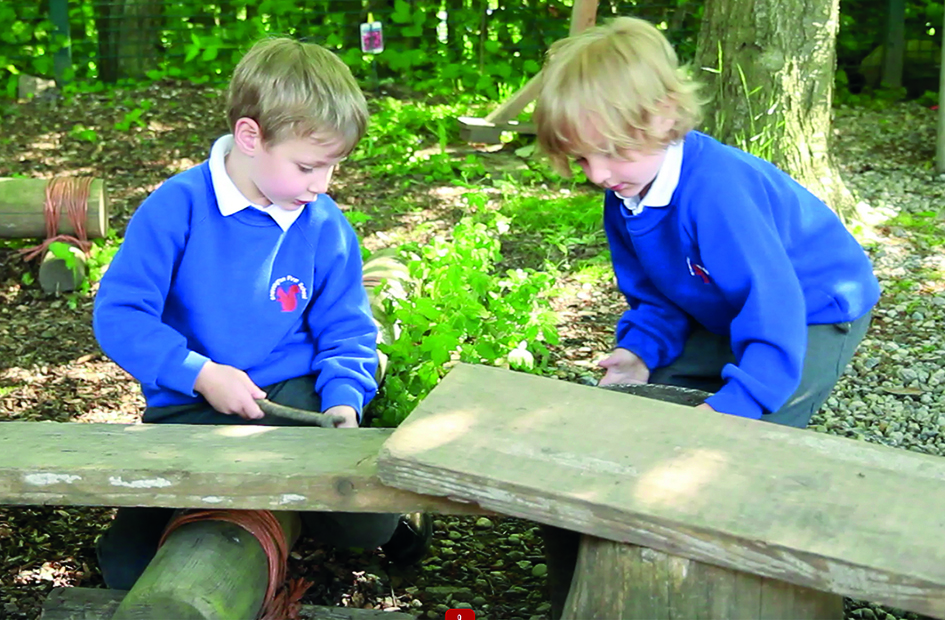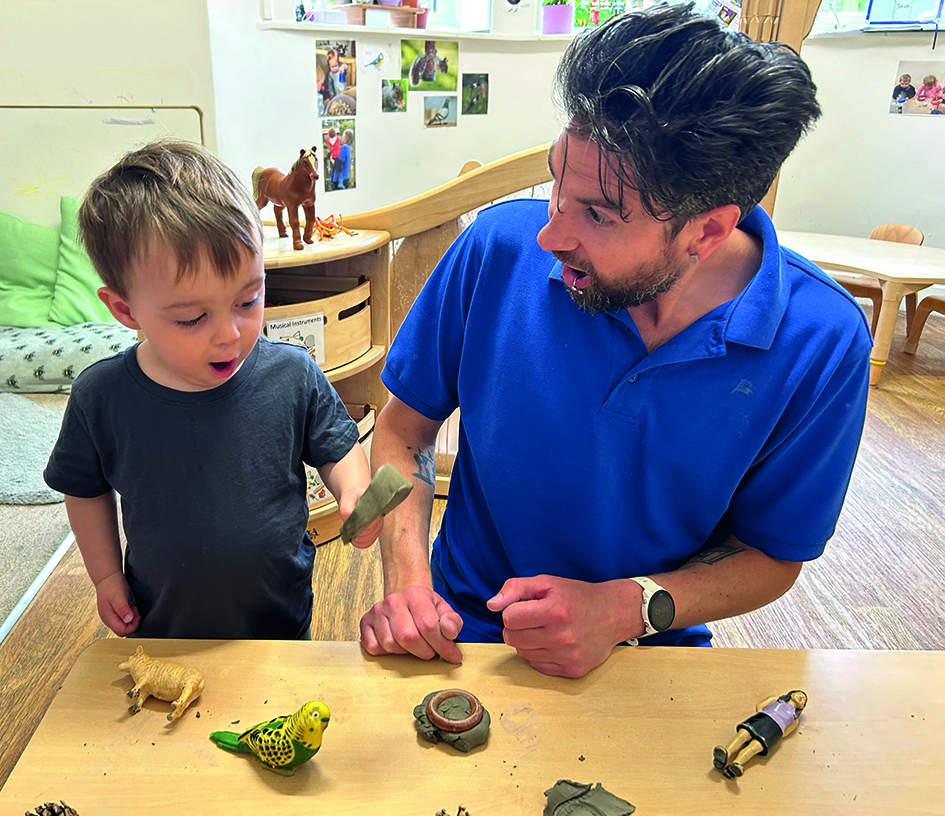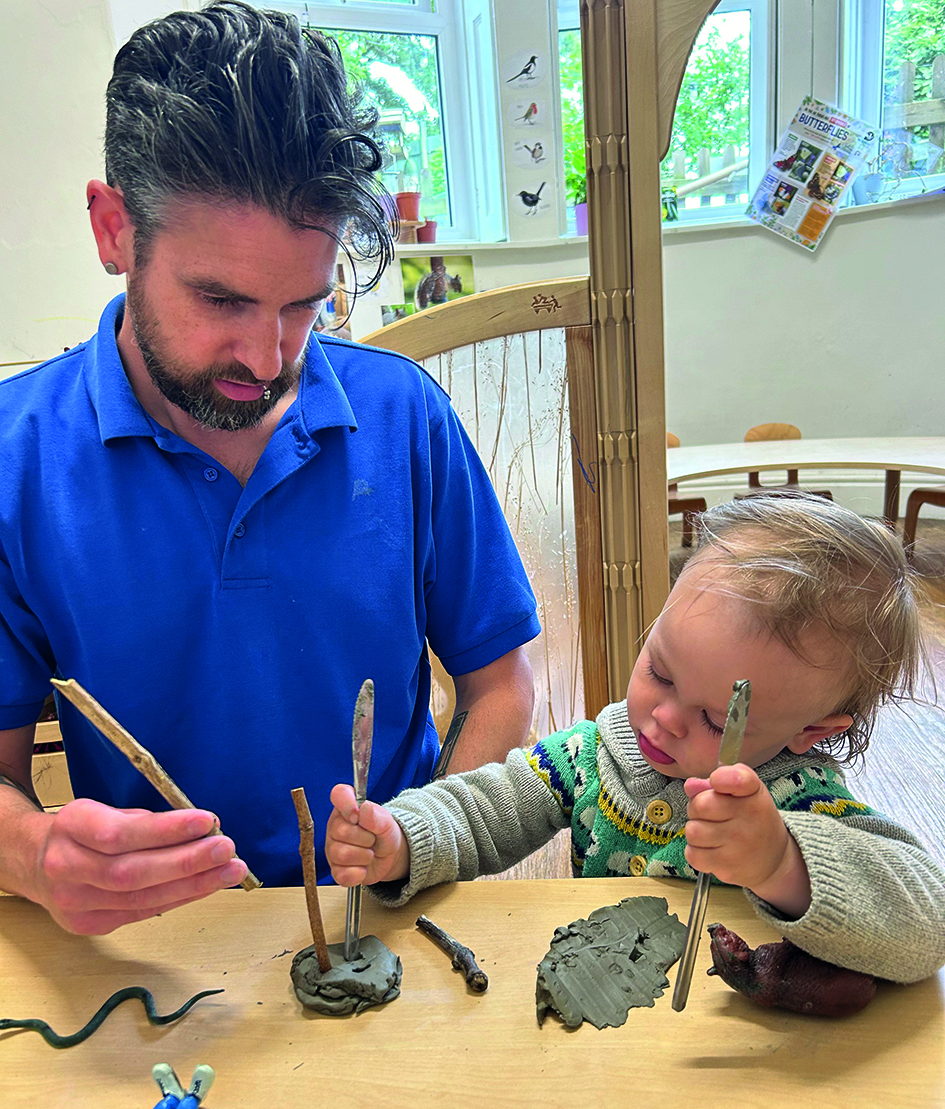
The previous three articles in this series have explored the background to the Characteristics of Effective Learning (CoEL) as well as looking at how educators can encourage engagement and motivation through play and active learning. This article investigates ways to support children in thinking creatively and critically.
However, just as the CoEL are connected to, and enmeshed, with each other, so these articles overlap and complement each other and are designed to be read as the quarters of a whole.
Being able to think creatively and critically is built on play and motivation. As Peter Gray (2013) explains, ‘Critical thinking is founded in creativity, and creativity always requires a degree of playfulness. The critical thinker plays with ideas – tries them out, turns them upside down to see what happens, explores their consequences.’
Birth to 5 Matters provides some examples of what this playful process of being creative and critical might look like:
- ‘As they play, children… think of their own ideas, imagine possibilities, and creatively combine ideas in spontaneous ways. They make meaning as they notice patterns and build their own working theories to make sense of their experiences, then make predictions and test them to refine their understanding.
- ‘Problems are identified, possible solutions invented, and with support children become increasingly able to monitor their efforts, to alter their approach flexibly when needed, and to review how well it went and what they have learned. This critical thinking becomes more conscious and under children’s control especially through talking with others about their thoughts, sharing and developing ideas together.
- ‘Adult-planned activities can offer scope for children to reinforce and develop their self-regulation and learning powers, when they are organised to include opportunities for children to explore, follow their interests and think for themselves – building on children’s engagement, motivation, and both creative and critical thinking.’
We can see all these aspects of thinking creatively and critically in action at https://www.sirenfilms.co.uk/library/building-a-path-2. A group of four- and five-year-olds have decided to build a path with some logs and planks in the school outdoor area. They have to communicate their ideas and work together. This is not an adult-planned activity and the children are talking with each other and doing all the physical work, but in the background you can hear an educator sometimes prompting their critical thinking.
Birth to 5 Matters considers Thinking Creatively and Critically under the three headings of:
- Having their own ideas (creative thinking)
- Making links (building theories)
- Working with ideas (critical thinking).
HAVING THEIR OWN IDEAS (CREATIVE THINKING)
 Imagination takes children from the here and now into the realms of possibility where anything may happen. Their new creative thinking is described under four sub-headings:
Imagination takes children from the here and now into the realms of possibility where anything may happen. Their new creative thinking is described under four sub-headings:
- Thinking of ideas that are new and meaningful.
- Playing with possibilities (what if? what else? ).
- Visualising and imagining options.
- Finding new ways to do things.
Stories are a powerful vehicle for imagination. After a year of focusing on storying with the two-year-olds in the atelier at their nursery and having collected many of the stories into a book called The Revolutionary Baby, the Reflections day nursery educators explain, ‘When we decide to focus on children’s stories, it is like tuning into a radio station that has always been broadcasting. The children’s stories don’t begin because we are listening but we hear them more clearly and in finer detail’ (Magnavacchi and Wilenski, 2015).
They started the year hearing ‘small’ stories about babies and families and ‘massive’ stories of monsters and giants. These stories generally followed quite conventional lines and did not cross over. However, when the educators introduced a 2.5cm model of a baby as a further provocation, something different happened: the baby travelled between stories.
‘At first he lived in the “baby place” which the children had built in papier mâché under a table. But he was also taken up into the “monster place”, a dark and dangerous place on top of the table with its black tower and raging battles. The baby mixed up not only the two worlds but the ideas they represented. We began to hear stories of baby monsters, friendly fires, babies who liked the dark and monsters who made milk.’
The Revolutionary Baby brings together many of the individual stories arising from this project, but one story runs all the way through – the story of two-year-old children thinking creatively of new and meaningful ideas and possibilities, visualising and imagining options and finding new ways to do things.
Here is one of two-year-old Etta’s stories:
My story is about some babies and a good fire.
The fire strokes the babies.
Then the babies stay with the good fire forever.
The good fire wasn’t hot.
The babies were teeny tiny.
They found the fire in the sea.
The good fire jumped in the sea.
The baby jumped in the sea to get the good fire.
They lived in somewhere else.
Somewhere nice with the good fire.
The most important aspect of the project was the way in which the educators gave the two-year-olds time to be creative as well as giving themselves time to listen reflectively, responding to the children’s ideas. Everyone can do that and provide open-ended resources and provocations for storying and thinking.
MAKING LINKS (BUILDING THEORIES)
 The two-year-olds at Reflections used the teeny tiny baby to make all sorts of connections. These connections helped them make predictions, test ideas and build theories. Birth to 5 Matters represents building theories under these headings:
The two-year-olds at Reflections used the teeny tiny baby to make all sorts of connections. These connections helped them make predictions, test ideas and build theories. Birth to 5 Matters represents building theories under these headings:
- Making links and noticing patterns in their experience.
- Making predictions.
- Testing their ideas.
- Developing ideas of grouping, sequences, cause and effect.
Here is an adult observing a child, giving her time and having a conversation which begins to unpack a theory. Emily (E) is four and Kath (K) is her teacher:
K: Have you seen the grass just here? (pointing to a frosty patch)
E: Yes it’s white and it’s cold
K: Look it’s sparkly
E: Yeah, Yeah, look! (running round on it)
K: Why do you think it’s like that?
E: There is frost on it
K: Yes
E: It’s really, really cold
K: Look, where I’m standing… there isn’t any here
E: No, no there isn’t
K: I wonder why that is
E: Because the frost isn’t coming down there
K: What do you mean?
E: There isn’t any frost coming down on it. Out of the sky.
K: Is there frost coming out of the sky where you are?
E: Yes
K: Is that where the frost comes from?
E: Yes look (reaching up with both hands and looking up to the sky) it’s coming down and down onto here (crouches down and touches the grass)
K: I can’t see it coming down
E: No
K: (standing on a non-frosty part of the grass) Why isn’t it coming down here then?
E: Don’t know
K: Look, this part is frosty too and this bit isn’t (both run from place to place in the garden looking at where the frost is).(Chilvers, 2013)
Kath starts the conversation, not with a question with one correct answer (‘What is this is on the grass?’), but by asking Emily if she has seen the grass. Kath does not know how Emily will respond and is not attempting to mould her answer in advance. What happens as a result is that they have a real chat, batting the conversational ball backwards and forwards. Kath notices that Emily appears to think frost falls like snow from the sky and does not contradict her theory but encourages her to think about why the frost is not covering all the grass.
Some might say that Kath should have explained frost formation and has missed an opportunity to correct Emily’s misconception. But that would be missing the point that the experience of being outside in the cold, on grass where there is ‘frost’ and ‘no frost’, is a playful outdoor sensory experience for Emily where she is able to enjoy conversation with a practitioner who is tuned into her and fascinated by her ideas. Kath now knows more about Emily’s theories and can use that knowledge to move her understanding on when the time is right.
What happens next is interesting…
K: Look at your shadow
E: Yeah, look (runs around)
K: Can you see my shadow?
E: Yes, it’s there
K: Can you see any other shadows anywhere?
E: No, there aren’t any more
K: I can see some
E: Where?
K: Look (pointing to a shadow made by a tree with several branches)
E: (excited) Oh yes, that’s one isn’t it
K: Whose shadow is that then?
E: I don’t know. It isn’t anybody’s
K: Where’s it coming from then? What’s making it?
E: I don’t know
K: Look at these long pointy lines. What do they look like?
E: Like a tree. They’re like the branches on a tree
K: Let’s follow this branch and along this straight bit (the shadow of the trunk). Oh we’re right up to the trunk (both standing pressed up against the trunk)
E: (laughing with arms round the trunk) Let’s go back up!
(They run up and down the shadow of the trunk several times)
K: Can you see any more tree shadows?
E: Yes, there’s one right here! (she runs over to another tree’s shadow and looks around) And one there.
(Chilvers, 2013)
Emily is now able to see the shadows made by the separate trees that she was unable to distinguish before and now understands that both humans and trees have shadows. She can use this connection to think about other things having shadows and about the frost. What makes this short interaction with Kath so effective is how Kath sees herself as an educator. She runs with Emily, sharing her physical excitement, and she runs mentally with Emily’s ideas. Emily is active in her own learning, taking Kath with her in this journey through frost and shadows.
WORKING WITH IDEAS (CRITICAL THINKING)
We can see in the revolutionary baby and in the conversation between Emily and Kath how important talk is to support thinking. All children use other forms of communication, some will always use alternatives. You do not need to be able to talk to have your own ideas and make decisions about what to do and how to do it. Readers may remember Ruby (five months) in article three who does all of those things as she works out how to get the out-of-reach toy she wants. However, for most children, talk becomes the main vehicle for thinking and skilful educators engage with children in sustained shared thinking, as we saw with Emily and Kath.
Sustained shared thinking has been defined as, ‘An episode in which two or more individuals “work together” in an intellectual way to resolve a problem, clarify a concept, evaluate activities, extend a narrative, etc. Both parties must contribute to the thinking and it must develop and extend’ (Siraj-Blatchford, et al., 2002).
SUSTAINED SHARED THINKING
 We can see the links between sustained shared thinking and how critical thinking is described in Birth to 5 Matters:
We can see the links between sustained shared thinking and how critical thinking is described in Birth to 5 Matters:
- ‘Planning, making decisions about how to approach a task, solve a problem and each a goal.
- ‘Checking how well their activities are going.
- ‘Flexibly changing strategy as needed.
- ‘Reviewing how well the approach worked.’
‘When adults supply language to describe creative and critical thinking as they observe them in action, children gradually develop greater awareness and control of their own thinking – they are developing metacognition. Adults can be the narrators of children’s thought processes, as far as they can understand them, and also think aloud to demonstrate the nature of their own thinking (e.g., “I wonder whether we will have time to finish that before lunch”, “I’m trying to remember what we said yesterday…”, “Maybe I could try using this stick”)’ (Stewart and Moylett, 2022).
The watchfulness, responsiveness and intention that we saw Kath demonstrating, as well as her knowledge of child development, is the basis of sustained shared thinking. When adults also use talk to scaffold children’s planning, monitoring their progress, and evaluating, they are helping children to learn strategies of thinking critically which can be gradually internalised.
There are lot of ideas on how to do this in Birth to 5 Matters (page 54), and we can see it happening in the Siren film mentioned earlier when the adult says things like ‘What has happened behind you?’ or draws attention to the importance of the process with ‘You guys weren’t listening to her’. She also reminds them that they need to monitor and evaluate their work, ‘There are still problems…you still need to sort that out.’
BUILDING STRONG FOUNDATIONS
The process of learning is complex and lifelong. The ways in which we encourage and extend children’s zest for learning in the early years build the foundations for later success socially, emotionally and academically. Our co-regulatory relationships with children help them to have positive emotional feelings about themselves as people and as learners (emotional self-regulation) and to develop awareness and control of their own thinking (cognitive self-regulation).
When we invest our time, care and attention in the learning process, it enriches both children and adults. As Gussin Paley (2004) says, ‘It is in the development of their themes and characters and plots that children explain their thinking and enable us to wonder who we might become as their teachers’.
FURTHER READING
- Chilvers D. (2022) ‘Thinking creatively and critically’ in Moylett H. (ed) (2nd Edn) Characteristics of Effective Early Learning: Helping young children become learners for life. Open University Press
- Grimmer T. (2018) School Readiness and the Characteristics of Effective Learning: The Essential Guide for Early Years Practitioners
- Sargent M. (2016) ‘Power Play’, Nursery World: https://bit.ly/4cip9yq
REFERENCES
- Chilvers D. (2013) Creating and Thinking Critically. MA Education
- EY Coalition (2021) Birth to 5 Matters
- Gray P. (2013) Free to Learn. Basic Books
- Gussin Paley V. (2004) A Child’s Work: The importance of fantasy play. University of Chicago Press
- Magnavacchi L. and Wilenski D. (2015) The Revolutionary Baby. On Reflection Publishing
- Siraj-Blatchford I. et al (2002) Researching Effective Pedagogy in the Early Years. DfES
- Stewart N. and Moylett H. (2022) in Moylett H. (ed) (2nd Edition) Characteristics of Effective Early Learning: Helping young children become learners for life. Open University Press









